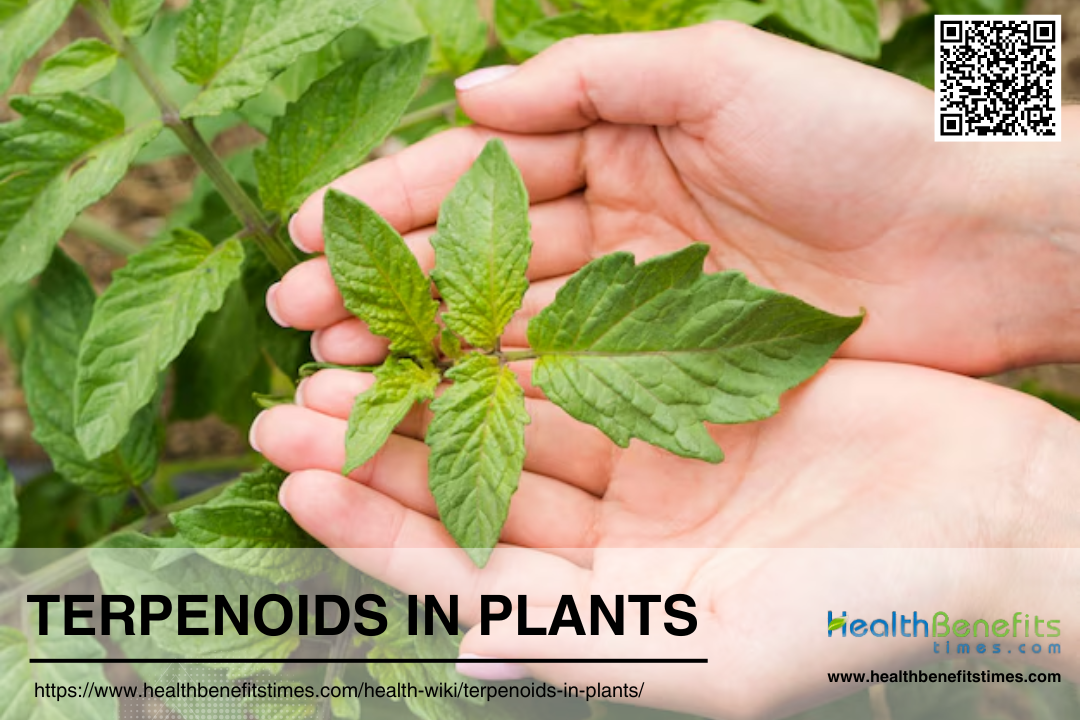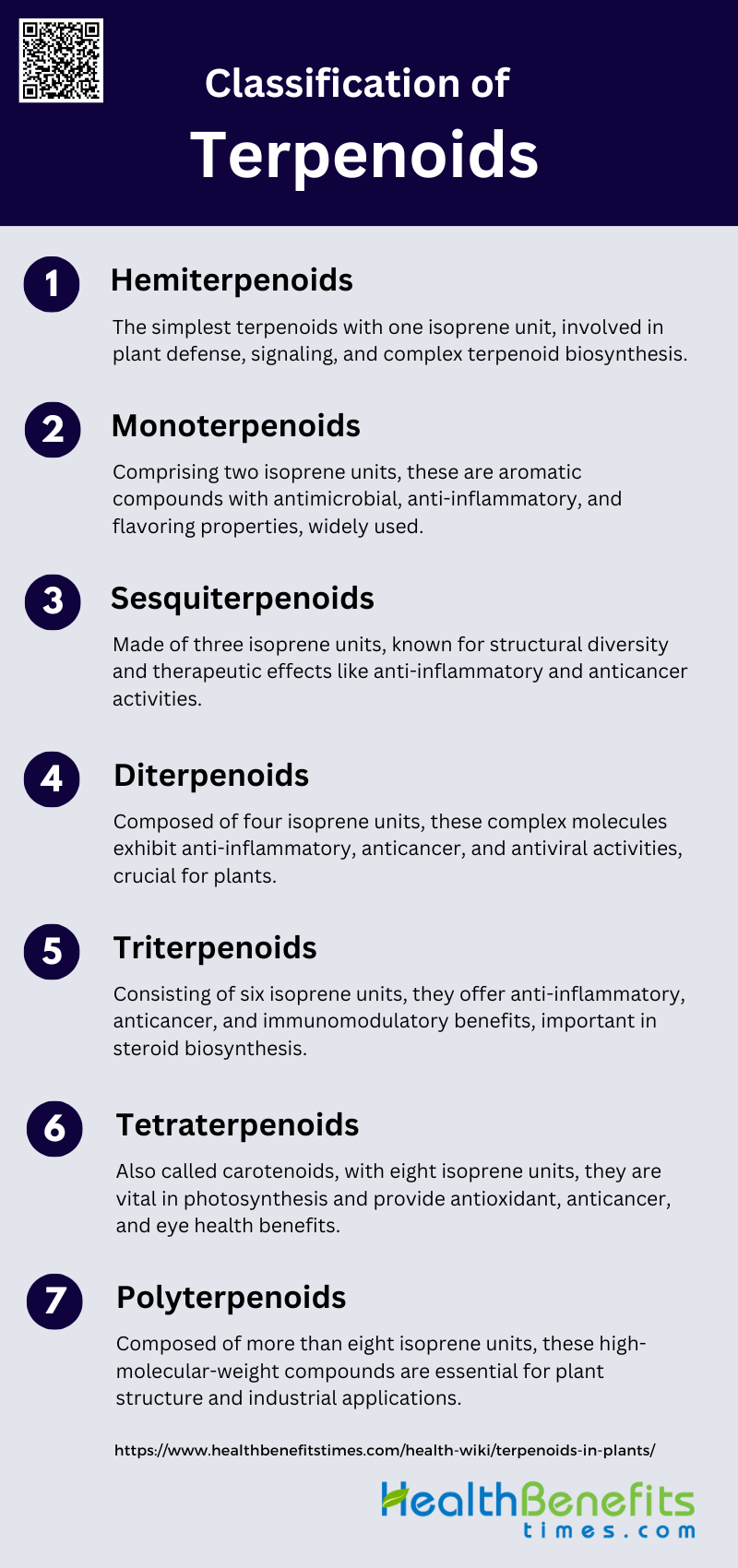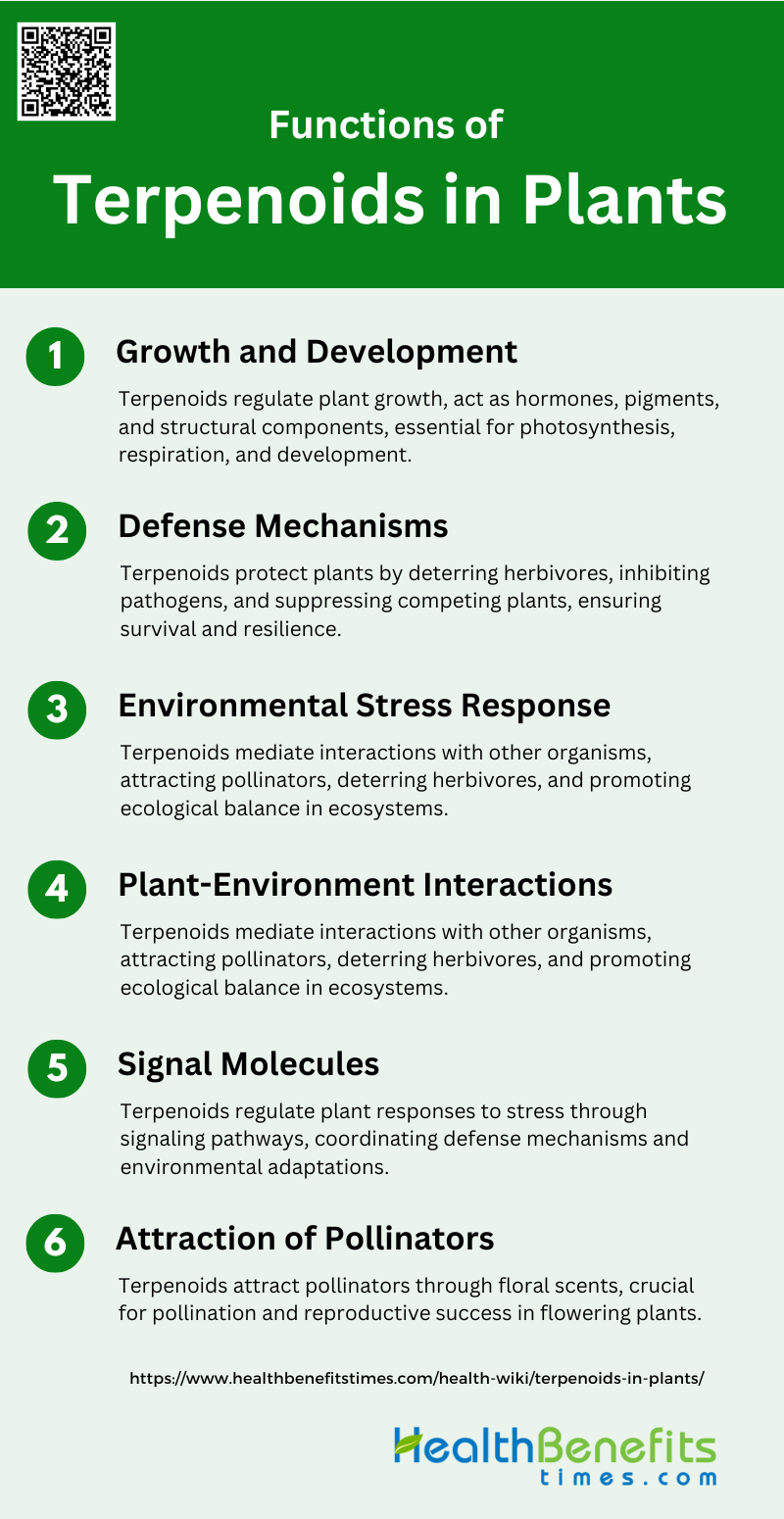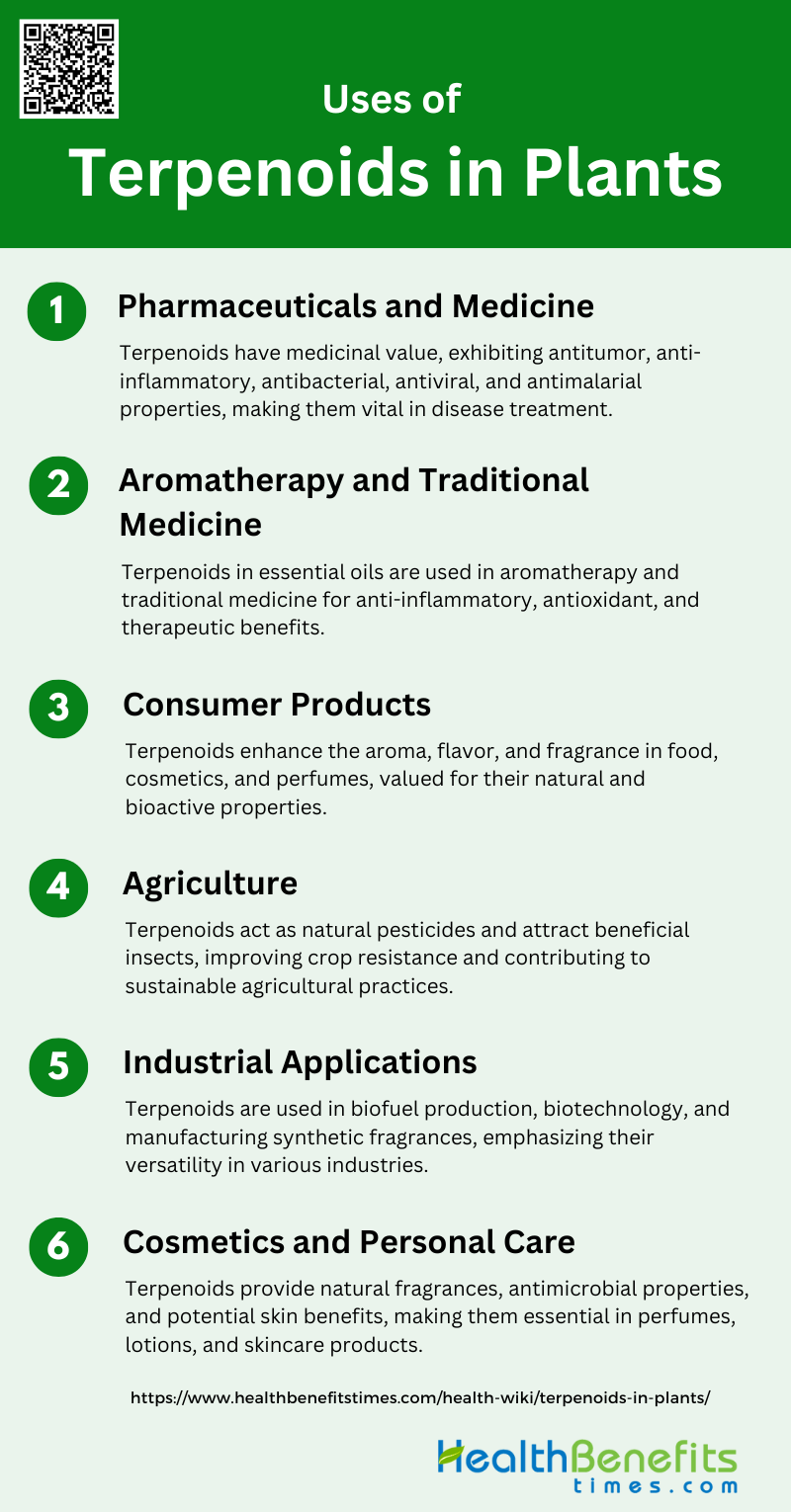Terpenoids, also known as isoprenoids, are a diverse class of naturally occurring organic chemicals derived from five-carbon isoprene units. They are widely present in plants and play crucial roles in various biological processes. Terpenoids are responsible for the aroma and flavor of many plants, contributing to the distinct scents of herbs like oregano, rosemary, and mint. They also have significant ecological roles, such as attracting pollinators and deterring herbivores. In addition to their ecological functions, terpenoids have been recognized for their medicinal properties, exhibiting antioxidant, anti-inflammatory, and antimicrobial activities. These compounds are involved in the biosynthesis of essential oils and are often used in traditional medicine and modern pharmaceuticals for their therapeutic effects.
Classification of Terpenoids
Terpenoids, a vast and varied group of organic compounds, are classified based on the number of isoprene units they contain. This classification not only highlights their structural diversity but also their wide range of biological functions and applications. Below is a detailed breakdown of the different Classification of Terpenoids:
1. Hemiterpenoids
Hemiterpenoids are the simplest form of terpenoids, consisting of a single isoprene unit (C5). They include compounds such as isoprene itself and its derivatives. Hemiterpenoids are found in various natural products and play significant roles in plant defense mechanisms and signaling pathways. They are also involved in the biosynthesis of more complex terpenoids through the mevalonate and methylerythritol phosphate (MEP) pathways.
2. Monoterpenoids
Monoterpenoids are composed of two isoprene units (C10) and are widely distributed in nature. They are known for their aromatic properties and are commonly found in essential oils of many plants. Monoterpenoids exhibit a range of biological activities, including antimicrobial, anti-inflammatory, and anticancer properties. They are also used in traditional medicine and as flavoring agents in the food industry.
3. Sesquiterpenoids
Sesquiterpenoids consist of three isoprene units (C15) and are known for their structural diversity and biological activities. They are found in various plants and marine organisms and have been studied for their potential therapeutic effects, including anti-inflammatory, antimicrobial, and anticancer activities. Sesquiterpenoids are also important in plant defense and as signaling molecules.
4. Diterpenoids
Diterpenoids are composed of four isoprene units (C20) and are known for their complex structures and diverse biological activities. They are found in a variety of plants and marine organisms and have been studied for their potential therapeutic effects, including anti-inflammatory, anticancer, and antiviral activities. Diterpenoids play significant roles in plant defense and development.
5. Triterpenoids
Triterpenoids consist of six isoprene units (C30) and are known for their structural complexity and wide range of biological activities. They are found in various plants and have been studied for their potential therapeutic effects, including anti-inflammatory, anticancer, and immunomodulatory activities. Triterpenoids are also important in plant defense and as precursors for steroid biosynthesis.
6. Tetraterpenoids
Tetraterpenoids, also known as carotenoids, are composed of eight isoprene units (C40). They are widely distributed in nature and are known for their vibrant colors and antioxidant properties. Tetraterpenoids play crucial roles in photosynthesis and photoprotection in plants. They have been studied for their potential health benefits, including anticancer, anti-inflammatory, and eye health-promoting effects.
7. Polyterpenoids
Polyterpenoids are composed of more than eight isoprene units (>C40) and include compounds such as natural rubber and gutta-percha. They are known for their high molecular weight and diverse structural forms. Polyterpenoids play significant roles in plant defense and structural integrity. They have been studied for their potential industrial applications, including the production of biopolymers and other materials.
Functions of Terpenoids in Plants
Terpenoids, a diverse class of organic compounds, play crucial roles in plant biology. They are involved in growth regulation, defense mechanisms, and environmental interactions. Below are the key functions of terpenoids in plants:
1. Growth and Development
Terpenoids play crucial roles in the growth and development of plants. They are involved in various physiological processes, including acting as hormones such as gibberellins and abscisic acid, which regulate growth and stress responses. Additionally, terpenoids function as photosynthetic pigments (e.g., carotenoids) and electron carriers (e.g., ubiquinone), which are essential for photosynthesis and cellular respiration. They also contribute to the structural integrity of cell membranes through compounds like phytosterols. These diverse roles underscore the importance of terpenoids in maintaining plant health and facilitating developmental processes.
2. Defense Mechanisms
Terpenoids are integral to plant defense mechanisms against a wide range of biotic threats. They serve as direct defenses by deterring herbivores and inhibiting the growth of pathogenic microorganisms. For instance, volatile terpenoids can repel herbivores and attract natural predators of these herbivores, thereby providing an indirect defense. Additionally, terpenoids can inhibit the growth of competing plants through allelopathic effects, which prevent seed germination and reduce soil microbial activity. These multifaceted defense roles highlight the significance of terpenoids in enhancing plant survival and resilience.
3. Environmental Stress Response
In response to environmental stressors such as extreme temperatures, water scarcity, and high salinity, plants produce terpenoids to mitigate damage and enhance tolerance. Terpenoids help in preventing oxidative stress by stabilizing cellular structures and scavenging reactive oxygen species. They also play a role in thermo-tolerance, allowing plants to withstand high temperatures, and in water stress responses by reducing water loss and maintaining cellular hydration. These protective functions enable plants to survive and adapt to harsh environmental conditions, particularly in arid and desert environments.
4. Plant-Environment Interactions
Terpenoids mediate a wide array of interactions between plants and their environment. They act as chemical signals that facilitate communication with neighboring plants, insects, and other organisms. For example, volatile terpenoids can attract pollinators and seed dispersers, enhancing reproductive success. They also play a role in deterring herbivores and attracting predators or parasitoids of herbivores, thus contributing to pest management. These interactions are crucial for maintaining ecological balance and promoting plant fitness in diverse ecosystems.
5. Signal Molecules
Terpenoids function as signal molecules that regulate various plant activities at both cellular and molecular levels. They are involved in signaling pathways that mediate plant responses to biotic and abiotic stresses. For instance, terpenoids can signal neighboring plants to activate their defense mechanisms upon herbivore attack. They also play a role in intra-plant signaling, coordinating responses to environmental changes and developmental cues. This signaling capacity underscores the role of terpenoids in orchestrating complex physiological and ecological processes in plants.
6. Attraction of Pollinators
One of the key ecological roles of terpenoids is in the attraction of pollinators. Floral volatile terpenoids (FVTs) are emitted by flowers to attract a wide range of pollinators, including bees, butterflies, and birds. These compounds contribute to the characteristic aromas of flowers, which serve as cues for pollinators to locate and visit the flowers. The emission patterns of these volatiles are often synchronized with the activity periods of pollinators, enhancing pollination efficiency. This attraction mechanism is vital for the reproductive success of many flowering plants.
Uses of Terpenoids in Plants
Terpenoids, a diverse group of naturally occurring organic chemicals, are vital to plant life. They serve various functions, from growth regulation to defense against herbivores and pathogens. Below are some of the primary uses of terpenoids in plants:
1. Pharmaceuticals and Medicine
Terpenoids have significant applications in pharmaceuticals due to their diverse biological activities. They exhibit properties such as antitumor, anti-inflammatory, antibacterial, antiviral, and antimalarial effects, making them valuable in treating various diseases. Notable examples include paclitaxel (taxol) and artemisinin, which are used in cancer and malaria treatments, respectively. Additionally, terpenoids like cannabinoids and thapsigargin are being explored for their therapeutic potential in medical research. The complex biosynthetic pathways of these compounds are being studied to enhance their production and efficacy in medicinal applications.
2. Aromatherapy and Traditional Medicine
Terpenoids are integral to aromatherapy and traditional medicine, primarily due to their presence in essential oils. These compounds are extracted from plants like tea, thyme, and citrus fruits, and are known for their therapeutic properties, including anti-inflammatory, antioxidant, and antiseptic effects. Essential oils containing terpenoids are widely used in aromatherapy to promote relaxation and alleviate stress. Traditional medicine systems have long utilized terpenoids for their medicinal benefits, such as curcumin from turmeric, which is renowned for its anti-inflammatory and antioxidant properties.
3. Consumer Products
Terpenoids are extensively used in consumer products, particularly in the food, cosmetics, and fragrance industries. They contribute to the aroma and flavor of various food items and beverages, enhancing their sensory appeal. In cosmetics, terpenoids are valued for their fragrance and potential skin benefits, making them common ingredients in perfumes, lotions, and creams. The versatility and natural origin of terpenoids have led to their widespread use in consumer products, catering to the growing demand for natural and bioactive ingredients.
4. Agriculture
In agriculture, terpenoids play crucial roles in plant defense mechanisms and crop protection. They act as natural pesticides, deterring herbivores and attracting beneficial insects like pollinators. Genetic engineering is being employed to enhance the production of terpenoids in crops, improving their resistance to pests and environmental stresses. Additionally, terpenoids are being explored for their potential to improve crop yield and quality by modulating plant growth and development. These applications highlight the importance of terpenoids in sustainable agricultural practices.
5. Industrial Applications
Terpenoids have significant industrial applications due to their diverse chemical properties. They are used in the production of biofuels, offering a renewable energy source with lower environmental impact. In the biotechnology sector, terpenoids are employed in the synthesis of high-value chemicals and materials. Their role in the fragrance and flavor industries also extends to industrial applications, where they are used to manufacture synthetic flavors and fragrances. The ongoing research in metabolic engineering aims to optimize the production of terpenoids for various industrial uses.
6. Cosmetics and Personal Care
In the cosmetics and personal care industry, terpenoids are prized for their aromatic properties and potential skin benefits. They are key ingredients in perfumes, lotions, and skincare products, providing natural fragrances and therapeutic effects. Terpenoids like limonene and linalool are commonly used for their pleasant scents and antimicrobial properties, which help in preserving cosmetic products. The demand for natural and bioactive ingredients in personal care products has driven the incorporation of terpenoids, enhancing the appeal and efficacy of these products.
Terpenoids in Everyday Life
Common Products Containing Terpenoids
Terpenoids are found in a wide range of everyday products due to their diverse biological activities and aromatic properties. Essential oils, which are rich in terpenoids, are commonly used in cosmetics, perfumes, and personal care products. These oils are extracted from plants and contain compounds like linalool, geraniol, and limonene, which contribute to their fragrance and therapeutic properties. Additionally, terpenoids are used in household cleaning products for their antimicrobial properties and in food and beverages as flavoring agents.
Aromatherapy and Essential Oils
Aromatherapy utilizes essential oils, which are rich in terpenoids, to promote mental and physical well-being. Essential oils such as lavender, rose, and citrus oils contain terpenoid alcohols like linalool, geraniol, and citronellol, which have been shown to have anxiolytic and mood-enhancing effects. These oils interact with the central nervous system, modulating neurotransmitter systems like glutamate and GABA, to provide sedative and anxiolytic benefits without the side effects associated with conventional drug therapies. This makes them a popular choice for relieving anxiety and depression through natural means.
Environmental Impact of Terpenoids in Plants
Role in Plant Ecology
Terpenoids play a crucial role in plant ecology by mediating various ecological interactions. They serve as chemical defenses against herbivores, both generalist and specialist, and protect plants from insect-vectored fungi and pathogenic endophytic fungi. Additionally, terpenoids attract beneficial organisms such as pollinators and entomophages, which help in plant reproduction and pest control. They also exhibit allelopathic effects, inhibiting seed germination and soil bacteria, thereby influencing plant community dynamics. These multifaceted roles underscore the importance of terpenoids in maintaining ecological balance and plant health.
Effect on Atmospheric Chemistry
Terpenoids significantly impact atmospheric chemistry by contributing to the formation of ozone (O3) and secondary organic aerosols (SOA), which affect air quality and climate change. They are common tropospheric species that react with atmospheric scavengers, influencing the oxidation capacity of the atmosphere. The emission of terpenoids is affected by various biotic and abiotic factors, including soil nutrients, temperature, and herbivory, which in turn alter their atmospheric concentrations and effects. Understanding these emissions and their interactions with atmospheric components is essential for accurate climate modeling and environmental management strategies.
FAQs
What are the primary pathways for terpenoid biosynthesis in plants?
Terpenoids are synthesized through two main pathways: the mevalonate (MVA) pathway and the methylerythritol phosphate (MEP) pathway. The MVA pathway occurs in the cytoplasm, while the MEP pathway takes place in the plastids.
Can terpenoids be synthetically produced for industrial use?
Yes, terpenoids can be synthetically produced through chemical synthesis or biotechnological methods, such as metabolic engineering in microorganisms, to meet industrial demand for these compounds.
What factors influence the production of terpenoids in plants?
The production of terpenoids in plants is influenced by factors such as environmental conditions (light, temperature, water availability), developmental stage, and plant stress (e.g., herbivory, pathogen attack).
How do terpenoids contribute to the flavor and aroma of foods?
Terpenoids are responsible for the distinct flavors and aromas in many herbs, spices, and fruits. Compounds like limonene in citrus and menthol in mint are examples of terpenoids that contribute to food’s sensory properties.
Are terpenoids found in all plants, or are they specific to certain species?
While terpenoids are widespread and found in a variety of plants, their specific types and concentrations vary significantly among different species. Some plants are particularly rich in certain terpenoids, contributing to their unique characteristics.
What are the potential environmental impacts of large-scale terpenoid production?
Large-scale production of terpenoids, especially through synthetic means, could have environmental impacts related to resource use, emissions, and waste. However, the biotechnological production of terpenoids using sustainable methods is an area of ongoing research.
How do terpenoids interact with other plant secondary metabolites?
Terpenoids often interact with other secondary metabolites, such as alkaloids and phenolics, to enhance plant defense mechanisms and ecological interactions. These interactions can result in synergistic effects that improve plant resilience.
What are the health risks associated with the use of terpenoid-rich products?
While terpenoids have many health benefits, excessive exposure or use of certain terpenoid-rich products can lead to allergic reactions or toxicity. It is important to use these products as directed and be aware of any personal sensitivities.
Are terpenoids used in any therapeutic applications beyond traditional medicine?
Beyond traditional medicine, terpenoids are being explored in modern therapeutics for their potential in treating diseases such as cancer, neurodegenerative disorders, and infectious diseases, often in combination with other drugs.
What role do terpenoids play in plant evolution?
Terpenoids have likely played a significant role in plant evolution by providing adaptive advantages in defense, reproduction, and interaction with the environment, contributing to the diversification and survival of plant species.





